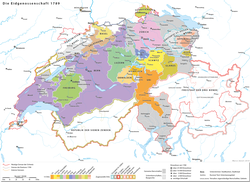Gemeine Herrschaft
| Republic of the Swiss | |||||
|
Eidgenossenschaft République des Suisses Republica Helvetiorum |
|||||
|
|||||
|
The Old Swiss Confederacy in the 18th century
|
|||||
| Capital | see Vorort | ||||
| Languages | Middle French / French, Alemannic German, Lombard, Rhaeto-Romansh | ||||
| Political structure | Confederation | ||||
| Legislature | Tagsatzung | ||||
| History | |||||
| • | Death of Rudolf I | 15 July 1291 | |||
| • | Rütlischwur, Burgenbruch | 1307/1291 (traditional dates) | |||
| • | Charles IV's Golden Bull | 1356 | |||
| • | Battle of Marignano | 13–14 September 1515 | |||
| • | Wars of Kappel | 1529 and 1531 | |||
| • | Formal independence from the HRE | 15 May/24 October 1648 | |||
| • | Swiss peasant war | January–June 1653 | |||
| • | Collapse | 5 March 1798 | |||

Swiss cross
(field sign 1470–1798)
The Old Swiss Confederacy (Modern German: Alte Eidgenossenschaft; historically Eidgenossenschaft, after the Reformation République des Suisses, Republica Helvetiorum "Republic of the Swiss") was a precursor of the modern state of Switzerland. It was a loose confederation of independent small states (cantons, German or ) which formed during the 14th century. From a nucleus in what is now Central Switzerland, the confederacy expanded to include the cities of Zurich and Berne by the middle of the century. This formed a rare union of rural and urban communes, all of which enjoyed imperial immediacy in the Holy Roman Empire.
This confederation of eight cantons (Acht Orte) was politically and militarily successful for more than a century, culminating in the Burgundy Wars of the 1470s which established it as a power in the complicated political landscape dominated by France and the Habsburgs. Its success resulted in the addition of more confederates, increasing the number of cantons to thirteen (Dreizehn Orte) by 1513. The confederacy pledged neutrality in 1515 and 1647 (under the threat of the Thirty Years' War), although many Swiss served privately as mercenaries in the Italian Wars and during the Early Modern period.
...
Wikipedia

